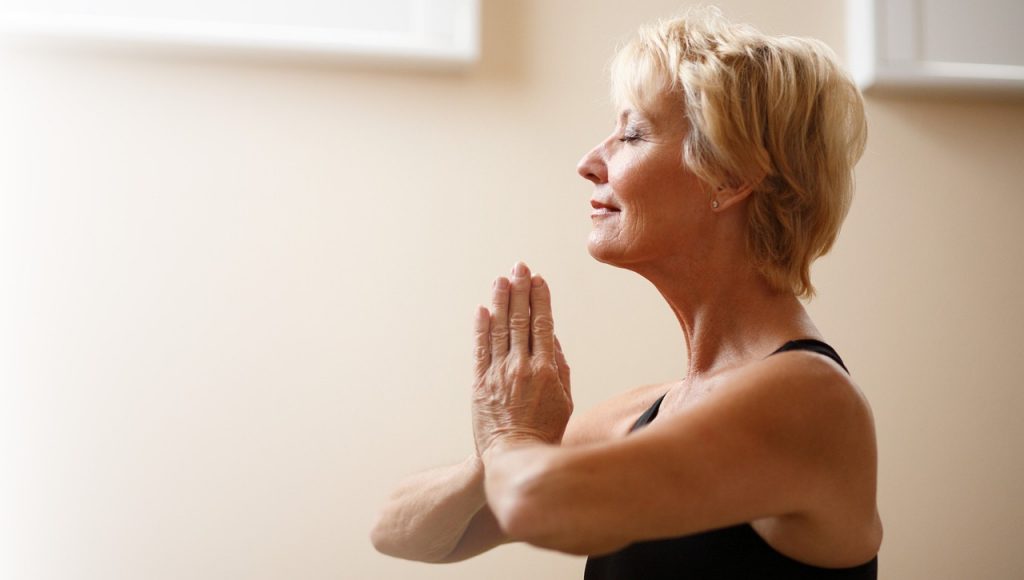Hashimoto’s thyroiditis can feel like your own body is setting limits that you didn’t know existed before.
If exercise suddenly feels harder than it should, you may not be imagining things. That’s because the condition affects not only your thyroid, but also your energy, muscles, joints, and ability to recover.

You may notice that
- Your muscles are sometimes stiff or weak
- Your joints feel unstable or painful
- You need longer to recover
- You are very flexible, but lack strength
- Your cardiovascular system is sensitive – e.g., with an unusually slow pulse, low exercise tolerance, or high blood pressure
These factors change how you move and how you tolerate exercise, and can lead to unconscious movement patterns that cause problems in the long term: joints become overloaded, pain develops, and poor posture creeps in. What your body needs here is not improved performance, but targeted support.
Hashimoto’s thyroiditis: between normal values and reality
Many people with Hashimoto’s thyroiditis take L-thyroxine and have well-regulated thyroid function according to their blood values – yet they still don’t feel well. Why? Because the autoimmune disease may still be active – regardless of the lab values.
Possible reasons:
- Individual response to L-thyroxine: The ideal dosage varies from person to person.
- Fluctuations & flare-ups: The thyroid gland can change constantly due to inflammatory flare-ups, which affects hormone levels.
- Absorption problems: L-thyroxine is not absorbed equally well by everyone, for example due to gastrointestinal problems or interactions with food.
- T3 deficiency: Some people need the active thyroid hormone T3 in addition to T4 (L-thyroxine).
- Stress & lifestyle: Stress, lack of sleep, diet, and other illnesses affect your hormone system.
- Psychosomatic factors: Psychological stress or intolerance to the medication can also exacerbate symptoms.
Normal values do not automatically mean you are symptom-free. Hashimoto’s affects the entire body. A holistic approach—including exercise, nutrition, stress management, and individualized therapy—can make a significant difference. Exercise is important for Hashimoto’s thyroiditis because it stimulates the metabolism, counteracts weight gain, and can alleviate general symptoms. It also improves physical fitness and well-being, which is particularly helpful for this chronic condition.
So the good news is: you can actively do something for yourself. With mindful exercise, targeted stability, and loving self-observation, you can effectively support your body.
Exercise has an anti-inflammatory effect
A recent study from 2024 shows that moderate exercise activates the formation of so-called myokines, i.e., proteins produced by the muscles that:
- reduce systemic inflammation,
- regulate the immune system
- and reduce the risk of autoimmune flare-ups.
👉 Exercise can therefore have therapeutic potential—provided it is dosed and individually tailored.
Physical symptoms from my practice
In my work with clients affected by Hashimoto’s thyroiditis or other autoimmune diseases, I often observe:
- Hypermobility and instability in the hips, knees, elbows, and spine
- Overstretching due to unconscious overexertion, especially in yoga or stretching
- Low joint stability despite high mobility, even in experienced yogis

Unconscious, imprecise movement can have serious consequences in the long term – especially in cases of joint instability or connective tissue weakness, which are more common in Hashimoto’s thyroiditis:
- Joint wear (osteoarthritis) due to permanent incorrect loading
- Overuse syndromes in the shoulders, elbows, knees, or lumbar spine
- Recurring injuries due to insufficient muscular stability
- Chronic pain due to compensatory movement patterns
- Premature fatigue and exhaustion because the body is constantly working against stability
People with a high degree of mobility (e.g., through yoga experience) are particularly at risk, as the “extra” movement masks the “lack” of control. That’s why mindful movement with a focus on stability is so crucial – even (and especially) if you don’t have any acute symptoms.
🧘♀️ Yoga and exercise: A healing combination – with mindfulness
Yoga can be a wonderful tool – if you adapt it to your needs. Not every style of yoga is suitable for Hashimoto’s thyroiditis, depending on the symptoms. Deep, passive stretches and “perfect” alignment often lead to overexertion in hypermobile or sensitive joints. Even experienced yoga teachers don’t always notice their own patterns – and a lot of online content (even professional) shows poses in which joints are not sufficiently stabilized.
This is not a criticism, but a reminder: Greater awareness of body signals and understanding of connective tissue is good for all of us – even professionals.

Perhaps you enjoy yoga because you find it easy to be flexible or you feel comfortable in long stretches. We often intuitively gravitate toward what we are good at. You don’t have to give up stretching – but how you stretch is crucial:
- Activate your muscles during the stretch – instead of letting yourself “sink” into it
- Focus on muscle control instead of maximum depth
- Avoid holding the stretch passively for a long time at the end of the movement
- Prioritize stability over flexibility
What about the heart? Hashimoto’s thyroiditis & circulation
As mentioned at the beginning, Hashimoto’s can affect not only your muscles, joints, and energy metabolism, but also your cardiovascular system. After looking at mobility and joint stability, it’s worth taking a closer look at this aspect – especially if you notice symptoms such as shortness of breath, dizziness, or heart palpitations during physical activity.
The effects affect not only the muscles but also the heart. The following symptoms may occur, especially if the thyroid function is not optimally adjusted:
- Slow pulse (bradycardia)
- Low cardiac output → fatigue, feeling cold
- High blood pressure (especially diastolic)
- Elevated cholesterol levels
- Long term: risk of arteriosclerosis
Endurance training should be done with caution, especially if you have newly diagnosed hypothyroidism or untreated Hashimoto’s disease.
🧭 Exercising despite heart problems – here’s how
If you notice symptoms such as shortness of breath, heart palpitations, dizziness, or pressure in your chest when exercising, then:
- 🩺 Get a medical check-up
- 📉 Keep an eye on your pulse and exertion
- 🚫 Avoid intense bursts of exertion or heat shock
- 🚶♀️ Focus on gentle forms of endurance exercise: walking, swimming, light cycling, water aerobics
With the right medication and adjustments to your training, your heart function may even improve.
🧘♀️ Integrative exercise = a matter of the heart
Gentle, holistic methods such as yoga, somatic bodywork, qi gong, or mindful walking not only benefit your heart, but also promote:
- a balanced nervous system
- less chronic inflammation
- better breathing and oxygen utilization
- confidence in dealing with fatigue or anxiety during exercise
💡 Tip: Incorporate breath-focused exercises to strengthen your vagal tone—this improves heart rate variability (HRV), an important marker of resilience in autoimmune diseases.
Tips for healthy exercise with Hashimoto’s thyroiditis
Based on recommendations from Medpertise.de, Mayo Clinic & my work:
- Start slowly & warm up well
- Build joint stability with functional exercises
- Prioritize muscle control over depth of stretch
- Exercise regularly, but moderately
- Choose joint-friendly activities: walking, swimming, cycling, gentle strength training, (therapeutic) yoga
- Listen to your body – not calorie or time goals
- Support your nervous system: with breathing exercises, mobilization, grounding
- Avoid or reduce exercise during an acute flare-up



Especially with autoimmune diseases such as Hashimoto’s thyroiditis, it makes sense to work with specialists who are familiar with the specific needs of exercise and training – particularly with regard to joint stability, cardiovascular stress, and fatigue tolerance. Make sure that your therapist, trainer, or yoga instructor has experience in dealing with chronic conditions and can make individual adjustments.
🕵️♀️ Fitness trackers: a smart tool
A fitness tracker can help you develop greater awareness of your body. This is particularly valuable in the case of Hashimoto’s thyroiditis, as your subjective feelings can vary greatly from day to day. Pay particular attention to:
- Heart rate & heart rate variability (HRV): These show you how rested your body is, which is important for avoiding overexertion.
- Sleep quality & duration: Poor sleep can exacerbate symptoms, so regular monitoring helps you identify good routines.
- Activity level & recovery: Trackers help you consciously plan not only your activity but also your rest.
- Stress level (if supported): Gives you clues when it’s time to slow down.
Important: Use the tracker as a reflection aid, not as a push. Your body sets the pace.
💬 Final thought
Your body is not too weak or too sensitive for exercise. It wants to be moved consciously, steadily, and with sensitivity. With the right knowledge, professional guidance, and self-compassion, exercise can go from being a challenge to your greatest resource—completely individual and healing.
Want to move your body—but safely, steadily, and in your own way?
In one-on-one sessions, I support you with therapeutic yoga, mindful bodywork, and health-oriented coaching. Together, we will find out what is good for you—beyond performance pressure or rigid exercise plans. For more stability, energy, and trust in your body—completely individualized, with sensitivity and professional guidance.
👉 Learn more about my health coaching & yoga therapy services here.


